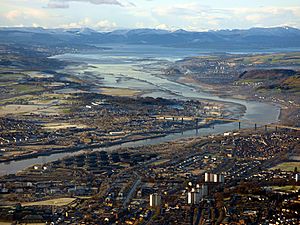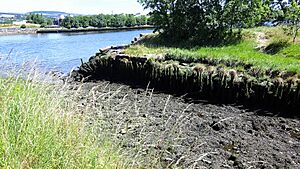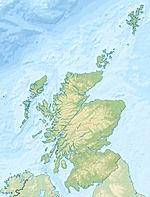Rashielee Quay facts for kids
Quick facts for kids Rashielee Quay |
|
|---|---|
 |
|
| Location | |
| Country | Scotland |
| Location | Erskine |
| Coordinates | 55°54′26″N 4°26′51″W / 55.907275°N 4.4473863°W |
| Details | |
| Opened | 18th-19th century |
| Operated by | Until late 19th century |
| Owned by | John Henderson Esq |
| Type of harbor | Private |
| Statistics | |
| Passenger traffic | No |
The old Rashielee Quay was a small port on the south bank of the River Clyde in Inchinnan, Scotland. It was built a long time ago, in the 18th or 19th century. Its main job was to help load boats and barges. These boats carried a special type of stone called whinstone. This stone came from the nearby Rashielee Quarries. A horse-drawn wagonway (like a small railway for horses) brought the stone from the quarries to the quay.
History of Rashielee
The land where Rashielee Quay was built has a long history. In 1497, a powerful family called the Stewarts of Barscube took ownership of Rashielee and other nearby lands. They owned these lands until about 1670. Then, a rich merchant from Glasgow, Donald Mac Gilchrist, bought most of the estate. He built the old North Barr House in 1676.
Over the years, the land changed hands many times. Different families and lords owned it, including the Balfours, Lord Sempill, John Buchanan, and Lord Blantyre. By 1856, John Henderson owned the Rashielee Plantation and the Rashielee Quarry.
The name 'Rashie' comes from an old Scottish word. It means an area or field that is full of rushes. Rushes are tall, grass-like plants that grow in wet places.
Rashielee Quarries
The Rashielee Quarries were two long, narrow pits. They dug out whinstone, a very hard and strong type of rock. This rock came from natural rock formations that ran through the area. Whinstone is great for building things that need to be tough. It was often used for pavements, roads, and jetties (small piers).
One important use for Rashielee whinstone was in building the 'Lang Dyke'. This was a long wall built in the River Clyde starting in 1773. It helped control the river's flow. The whinstone was floated down the river on barges and placed underwater. Later, more whinstone from Rashielee was used to make the Lang Dyke even longer. It was also used to protect other parts of the River Clyde from erosion. This included areas near Bodinbo Island and the old Erskine Ferry.
The quarries stopped working by 1881. When they closed, many people lost their jobs. This caused the local population to drop. Today, you can still see some of the old quarry faces. They are visible from the walking paths that now go through the area.
Rashielee Quay's Purpose
The quay was built to make it easy to load ships and barges. These boats would then carry the whinstone stone to different places along the River Clyde. The stone was used for various building projects.
In 1857, tracks ran from both quarries right to the quay. These tracks split into several smaller lines. They ended where a crane was located. This crane helped lift the heavy stone onto the boats. There was also a beacon (a light for ships) and several places for boats to dock. One of these was a small dock or basin.
By 1895, the quarries were no longer used. The tracks were removed, and the quay seemed to be abandoned. However, maps from that time still showed a crane there. Some cottages, called Rashielee Cottages, were located where a building had been when the quarries were busy.
By 1939, official maps showed the quay as "disused," meaning it was no longer in use. The area around the quay has since been filled in and made into a park-like space. Much of the stone from the old quay was used in this new landscaping.
Near Rashielee Quay, there is a light called Rashielee Light. It stands on a metal pole in the river. It used to run on oil, then on gas, and now it uses electricity.
World War II
During World War II, a barrage balloon site was located in this area. Barrage balloons were large balloons tethered to the ground. They had steel cables hanging from them. Their purpose was to make it harder for enemy German aircraft to fly low and attack. Many of these balloons were placed along the Clyde to protect people, homes, and factories. Today, nothing remains of the barrage balloon structure at Rashielee.




